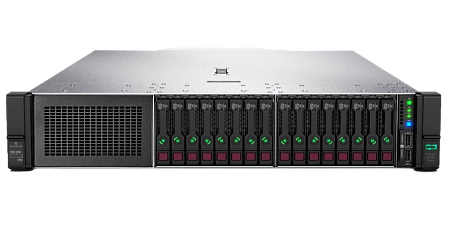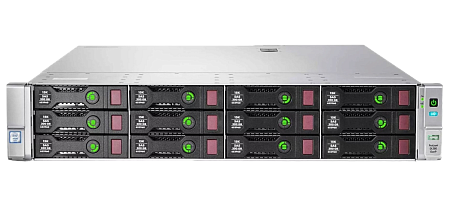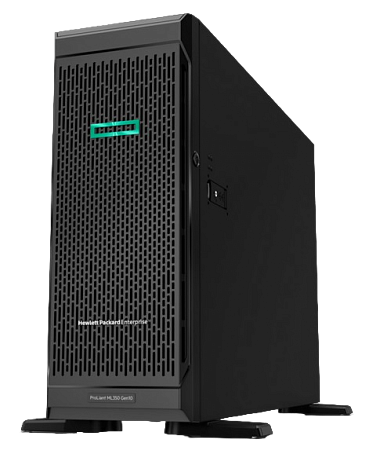6th Generation MSA storage (MSA Gen6) was released in 2020. It has SAS (12Gb, iSCSI 10Gb and FC 16Gb) interfaces, just like the 5th generation. Moreover, 10GBase-T support was implemented here, which increases its popularity.
The MSA Gen6 series includes three models:
-
MSA 1060: Entry-level storage at an affordable price.
-
MSA 2060: flexible storage option for larger-scale projects, as well as for high and constantly changing loads.
-
MSA 2062: complete and multifunctional storage system with pre-installed SSD and advanced functionality licenses.
It is worth noting that the MSA Gen6 chassis is not compatible with elements of previous generations. This means that you cannot use outdated components in the new system. Such components are listed below:
-
Disc baskets;
-
Power and cooling modules;
-
Controllers;
-
Storage devices;
-
Transceivers;
-
Front grilles.
Next, we are going to consider the latest MSA 2060/2062 model.
MSA 2060/2062 Design
The HPE MSA 2062 is an MSA 2060 chassis with two 1.92 TB RI SSD drives. The use of automated Touring 2.0 is possible due to the availability of an Advanced Data Services Suite (ADS) license.
HPE MSA 2060/2062 is created in a 2U form factor and is available to customers in two versions – SFF and LFF.
The supported drive types are listed below:
-
SED: Self Encrypting Drives;
-
SSD RI (Read Intensive): can be applied for high-performance data storage or read caching (Performance Tier/Read cache);
-
SAS HDD 7.2K Midline for the Archive tier;
-
SAS HDD 15/10K Enterprise class for Standard tier.
Architecture and Models of MSA 2060
The MS 2060 platform series includes 8 storage models, the difference between which is in the type of form factor drives and controllers:
-
HPE MSA 2060 10GBASE-T iSCSI SFF Storage R7J73A.
-
HPE MSA 2060 10GBASE-T iSCSI LFF Storage R7J72A.
-
HPE MSA 2060 12Gb SAS SFF Storage R0Q78A.
-
HPE MSA 2060 12Gb SAS LFF Storage R0Q77A.
-
HPE MSA 2060 10GbE iSCSI SFF Storage R0Q76A.
-
HPE MSA 2060 10GbE iSCSI LFF Storage R0Q75A.
-
HPE MSA 2060 16Gb Fibre Channel SFF Storage R0Q74A.
-
HPE MSA 2060 16Gb Fibre Channel LFF Storage R0Q73A.
Every controller is equipped with 4 ports (8 per system).
MSA 2060/2062 additional disk baskets:
-
Storage baskets of previous generations of MSA are not supported;
-
Maximum 9 baskets in one system;
-
2 types of baskets – SFF and LFF form factors are supported;
-
Up to 240 SFF drives, or up to 120 LFF drives are available;
-
SFF and LFF storage baskets can be used together.
Connecting baskets with MSA 2060 drives
The cabling process has been much simplified, as now the two-meter SAS cables in the MSA 2060 are not needed to connect the lowest baskets.
Licensing
For MSA 2060, the ADS Suite (Advanced Data Services) license is purchased additionally. For MSA 2062, the ADS Suite license is already included. The license provides the following features:
-
Remote Snap Replication (RSR) function;
-
Up to 512 volume snapshots per system;
-
Tiering data storage using SSD.
You need the license in the following cases:
-
When it is required to use a high-performance storage tier and lower tiers (standard and archive) on HDDs in the same pool.
-
When a high-performance storage tier and lower tiers are included in the same system.
The license is not required in the following cases:
-
For SSD as a read cache.
-
For "SSD only" or "HDD only" configurations for standard or archive tier (provided they are in the same pool).
Disk groups and pools
A group can contain only 1 type of disk, which is automatically assigned to the corresponding tier in the enclosure.
| SSD | Performance Level/SSD Read Cache |
|
15/10K Enterprise-SAS |
Standard level |
|
7.2K Midline-SAS |
Archive level |
Each pool can include up to 1, 10, 5 or 6 disks with RAID backup or 16 disk groups with MSA-DP+ support.
RAID 10, 5 and 6 can support up to 16 drives. RAID 1 includes up to 2 drives. MSA-DP+ can contain up to 128 drives.
MSA Gen6 Innovations
Management:
-
Supported by HPE MSA Health Check.
-
New REST interface according to the Redfish standard.
-
New target-based web interface (4th version).
-
Notifications about the availability of new firmware.
Chassis:
-
New MSA chassis with Gen 10 style grille.
-
A kit for locking the front grille (bezel kit).
-
Expansion baskets for drives (for 12 LFF and 24 SFF)
-
Next-generation storage modules.
-
SAS midplane.
Storage services:
-
New type of disk group (MSA-DP+), responsible for:
-
Incremental expansion of a disk group.
-
Super-fast rebuilds.
-
Integrated backup.
-
Increased performance level along sequential recording.
-
Return to the active element after backup switching and restoration of the active element (failback).
-
Asynchronous replication of the entire array.
-
Virtual storage:
-
SSD Cache expansion.
-
Volume Copy.
-
Automated tiering v2.0.
-
Capacity allocation on request (Thin provisioning).
-
Up to 2 storage pools.
Controllers:
-
Connecting controllers is carried out in accordance with the “active-active” scheme.
-
Controller per protocol (converged SAN controllers are not applied).
-
Fiber Channel, iSCSI (SFP+ and 10GBase-T) and SAS protocols are available.
-
In order to unload RAID, new generation ASIC and CPU chips are used.
-
24 GB system cache.
-
12G SAS expansion ports.
MSA-DP+ Backup:
-
It provides the following improvements:
-
Flexible expansion from 12 to 128 disks.
-
Increased performance and availability level.
-
Super-fast recovery.
-
Integrated backup: no unused disks.
-
Support for different disk space in the same group.
Automated tiering 2.0
Automated tiering functions at the pool level and is always enabled. It starts functioning when adding 2 or more drive types to a pool (SSD к Enterprise SAS). At the same time, the data is transferred to tier more appropriate to the frequency of use. "Hot" data is moved to the next level of increased performance. "Cold" data is transferred to the standard tier, and when the frequency of use reduces, it is moved to the archive tier. The data is transferred every 5 seconds. You cannot move the same page more than 15 times in 1 minute. High performance tier includes about 5% of free capacity required for read-record operations of new data.
The stream detection function is responsible for analyzing write-read operations from apps, as well as for sending the corresponding streams to a specific level.
Remote snap replication
Remote snap replication – is a feature licensed as part of the Advanced Data Services (ADS) kit. It can be used as a method for DR (disaster recovery). This function is available only for FC or iSCSI.
Power modules
Upon pre-order, all types of storage systems can be equipped with power modules from an external DC source. AC power modules are embedded into MSA Gen6 arrays by default. The slot for backup batteries is not applied (not orderable).
Storage management utility v4
SMU is a web interface specially designed in order to manage the MSA line. MSA Gen6 is provided bundled with the SMA v4 version, which has a number of advantages. Below we will consider v4 innovations relative to SMUs of other MSA generations:
-
Easy inclusion of new firmware options;
-
Simplified control panel;
-
Improved appearance;
-
Dynamic screen update;
-
Automatic notifications about the accessibility of new firmware options;
-
Grouping logical activity;
-
Improved process of installing a new array "out of the box" OOBE (Out of box experience).
Full Disk Encryption
The encryption function is only available for MSA 1060 and 2060. MSA 2062 goes on sale with two SSDs without encryption. Even if they are deleted, the array will support encryption, but this is an uneconomical solution. For this reason, encrypted drives are not considered as an additional option. FDE must be supported by all drives in the array to be applied successfully.
Managing level proportions
“Best Practice” Example
In hybrid configurations, the performance level volume on the SSD is defined at 10-20% depending on:
-
Pool volume with 2 tires;
-
Volume of the Standard level using 3 tires;
The proportions of the Archive level should not be exceeded:
-
When using 2 levels (Standard + Archive), the Archive volume should not be more than 50%;
-
In three-level configurations, the Archive volume should not be more than 66%.
Even if this configuration is supported, it is not the best decision to set up SSDs and 7.2K MDL-SAS drives without the 3rd ENT-SAS level.
Conclusion
All 6th generation platforms are incompatible with the previous generation in a number of parameters (drives, baskets, controllers). Nevertheless, there are important advantages here:
-
advanced functionality,
-
support for 10GBase-T iSCSI,
-
increased efficiency level.
HPE MSA 2060/2062 uses the new improved version of SMU v4. The process of installing a new OOBE array (Out-Of-Box experience) is simplified as well.
Thus, the main differences between HPE MSA 2062 and MSA 2060 are:
-
two 1.92 TB RI SSDs that come with the HPE MSA 2062,
-
advanced Data Services Suite licenses (Tiering 2.0. is available).
Specialists of our company are ready to help you purchase the server and select the necessary server configuration for any required task.
































